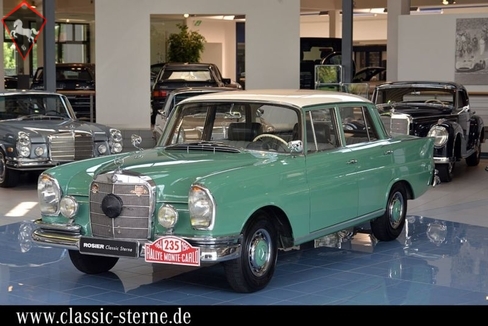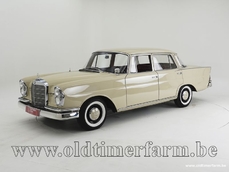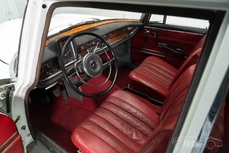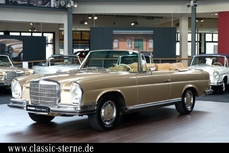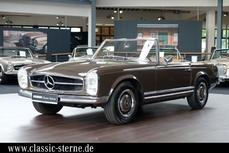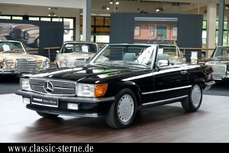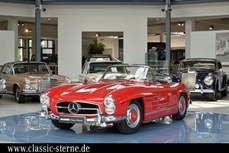Mercedes-Benz 220S w111 Fintail Sb "Heckflosse" Rallye Monte Carlo Fahrzeug 1963
General description :
Interne Fahrzeugnr.: 20371_Mercedes_Benz
Ansprechpartner: Gross, Dietrich - 0441 209780 12
Kaum auf dem Markt zu bekommen sind originale Rallye-Fahrzeuge aus den 1950er und 1960er Jahren. Meist wurden die Fahrzeuge parallel im normalen Straßenverkehr eingesetzt und Ihr ruhmreiches Doppelleben wurde in der Öffentlichkeit nicht bekannt. Wir freuen uns sehr, Ihnen mit dem hier angebotenen Wagen ein tolles Original mit eindrucksvoller Rallye-Geschichte anbieten zu können. Diese Mercedes-Benz 220S Limousine wurde in 1963 im Werk fertiggestellt und gleich nach seiner Übergabe an den damaligen Erstbesitzer, nach den Vorgaben der in 1963 gültigen Rallyereglements, modifiziert. Diverse Versteifungen der Karosserie wurden vorgenommen, bessere Scheinwerfer und Zusatzscheinwerfer wurden verbaut, ebenso wie Sportstoßdämpfer. Der Motor wurde so modifiziert, dass er auch mit Kraftstoff schlechterer Qualität auskommen konnte.
Der erste Besitzer lebte im Süden Frankreichs, im Arrondissement Narbonne, nahe der spanischen Grenze. Er war automobilbegeistert und der deutschen Rallyeszene äußerst zugetan. So wurde der Wagen zum Teil mit hochkarätigen Fahrern und Beifahrern bestückt, bei verschiedenen hoch angesiedelten Veranstaltungen in Deutschland eingesetzt.
1963 Rallye Avus Berlin
1963 Rallye Bad Neuenahr
1964 Rallye Monte Carlo vom Startort Frankfurt aus beginnend. Hier hatte der Wagen die Startnummer 235 und wurde von den Rennfahrern Pape und Eger pilotiert. Der Wagen blieb 40 Jahre im ersten Besitz und wurde in 2004 an seinen 2. Besitzer, einen Rallyefreund aus der Gegend zwischen Straßbourg und Colmar, verkauft. Auch er setzte den Wagen bei verschiedenen hochkarätigen Veranstaltungen für Klassische Fahrzeuge ein.
2006 Acropolis Rallye
2007 und 2008 Winter Drive
2009 Rallye Monte Carlo Historique
2010, 2011 und 2012 Rallye Meznec
In 2013 kam der Wagen in deutschen Besitz. Wiederum ein Rallye und Rennsportbegeisterter Unternehmer hatte sich in den Mercedes verliebt. Er behandelte den Wagen pfleglich und war begeistert von seiner Originalität. Sein Wunsch nach mehr Leistung und Schnelligkeit bewog Ihn jedoch, den Wagen gegen einen kernigen Vorkriegsrennwagen einzutauschen. So freuen wir uns heute, Ihnen diese Rarität anbieten zu können. Der Wagen hat einen FIVA Pass mit der super Einstufung A/2 und gehört zu den so gesuchten „matching numbers“ Fahrzeugen. Der Zustand ist bestens. Man merkt, dass der Wagen immer bei automobilbegeisterten Fahrern war, die es an Pflege und Instandhaltung nie haben fehlen lassen.
Für weitere Detailinformationen zu diesem Fahrzeug oder Interesse an einem Besichtigungstermin kontaktieren Sie unser Verkaufsteam Dietrich Gross 0441-209780-12 oder Daniel Krzykowski 0441-209780- 11.Unseren aktuellen Fahrzeugbestand finden Sie unter http://www.classic-sterne.de
Zubehörangaben ohne Gewähr, Änderungen, Zwischenverkauf und Irrtümer vorbehalten!
powered by two S
https://home.mobile.de/ROSIERCLASSICSTERNEGMBH#des_255888811
1963 Mercedes-Benz 220S w111 Fintail Sb "Heckflosse" Rallye Monte Carlo Fahrzeug is listed sold on ClassicDigest in Bremer Heerstraße 267DE-26135 Oldenburg by Auto Dealer for €67500.
Car Facts
Car type : Car Make : Mercedes-Benz Model : 220S w111 Fintail Model Version : Sb "Heckflosse" Rallye Monte Carlo Fahrzeug Engine size : 2.2 Model Year : 1963 Sub type : Sedan Location : Bremer Heerstraße 267DE-26135 Oldenburg
Sold
Seller Information
Sold
People who viewed this Mercedes-Benz 220S w111 Fintail also viewed similar Mercedes-Benz listed at ClassicDigest
Other cars listed for sale by this dealer
About Mercedes-Benz
In the annals of automotive history, the journey of Mercedes-Benz is a tale that unfolds with the ingenuity of its founding pioneers. In the year 1886, Karl Benz crafted the Benz Patent Motorwagen, a creation that would go down in history as the world's inaugural automobile. Unbeknownst to him, this moment marked the genesis of what would evolve into the most illustrious premium car manufacturer globally. The financial underpinning of this pioneering venture, interestingly, was provided by Karl Benz's wife, Bertha Benz, demonstrating a remarkable partnership that would set the tone for Mercedes-Benz's legacy.A parallel narrative emerged not far away, as Daimler-Motoren-Gesellschaft, founded by Gottlieb Daimler and Wilhelm Maybach, entered the scene. In 1901, they unveiled their automobile under the now-famous moniker "Mercedes," meaning "godsend" in Spanish. This name was bestowed upon the car at the behest of Emil Jellinek's daughter, the distributor for Daimler-Motoren-Gesellschaft. The wheels of innovation were set in motion.
Fast forward to 1926, a pivotal year that witnessed the merger of Daimler with Benz & Cie., culminating in the birth of Daimler-Benz. The amalgamation saw the adoption of "Mercedes-Benz" as the distinguished trademark for their automobiles, fusing the legacies of two visionary entities into one.
Contrary to perceptions of conservatism, the trajectory of Daimler-Benz unfolds as a chronicle of industry firsts. From the introduction of the honeycomb radiator to the float carburetor, and the pioneering implementation of four-wheel brakes in 1924, Daimler-Benz consistently pushed the boundaries of automotive innovation. The diesel-powered Mercedes-Benz 260 D in 1936 marked the inception of diesel engines in passenger cars. The iconic Mercedes-Benz 300SL Gullwing made history as the first car with direct fuel injection, albeit the Gutbrod's tiny 2-stroke engine can claim precedence.
Safety innovations became a hallmark, with Béla Barényi's patented safety cell design in the "Ponton"-models in 1951, featuring front and rear crumple zones. The W116 450SEL 6.9 saw the introduction of the Anti-Lock Brake system (ABS), another pioneering safety feature. From the first production airbags and beyond, the legacy of "firsts" continued to be etched into the fabric of Daimler-Benz.
Over its centennial journey, Mercedes-Benz has not merely produced cars but has sculpted automotive icons. The SSKL, 710 SSK Trossi Roadster, 770K Grosser, 540K Spezial Roadster, 300SL Gullwing, w100 600 Pullman, w111 280SE 3.5 Flachkühler, w113 230SL Pagoda, w109 300 SEL 6.3, and w201 2.3-16 Cosworth stand testament to the brand's commitment to engineering excellence.
The roaring Silver Arrows, or "Silberpfeile," including the W 25, W 125, W154, W165, and W196, created a legacy of dominance on the racetrack. These machines were not merely cars; they were expressions of precision, speed, and an indomitable spirit that left their competitors in the dust.
As Mercedes-Benz marches into the future, it does so not just as an automaker but as a custodian of a legacy, a torchbearer of innovation, and a beacon of automotive excellence. The road ahead is sure to witness the continued fusion of cutting-edge technology, timeless design, and an unwavering commitment to setting new standards in the world of automobiles.
One luminary figure who left an indelible mark was Béla Barényi, often heralded as the "father of passive safety" for his pioneering work in safety engineering. His patented safety cell design, featuring front and rear crumple zones, became a hallmark of Mercedes-Benz's commitment to occupant safety, setting new standards that reverberated throughout the automotive world.
Moving through the chronicles, the collaborative genius of Wilhelm Maybach, alongside Gottlieb Daimler, laid the foundation for Daimler-Motoren-Gesellschaft. Their innovations not only birthed the first Mercedes but established a culture of relentless pursuit of technological excellence that remains integral to Mercedes-Benz's DNA.
In the post-merger era of 1926, Ferdinand Porsche emerged as a prominent figure within Mercedes-Benz. His work on the Mercedes-Benz S-Type, a supercharged race car, garnered acclaim and set the stage for a legacy that extended far beyond the marque. Porsche's impact would later extend to his eponymous company, but his influence at Mercedes-Benz during those formative years was pivotal.
As the 20th century progressed, the legendary Rudolf Uhlenhaut emerged as a key figure. Uhlenhaut, an accomplished engineer and the driving force behind the iconic Silver Arrows, played a crucial role in Mercedes-Benz's dominance in motorsports. His engineering prowess and attention to detail were instrumental in creating some of the most formidable racing cars of the era.
In the latter half of the century, figures like Bruno Sacco, the head of design at Mercedes-Benz from 1975 to 1999, left an indelible imprint on the brand's aesthetic identity. Sacco's design philosophy, characterized by clean lines and timeless elegance, shaped iconic models like the W126 S-Class and the W201 190E, solidifying Mercedes-Benz's reputation for luxury and sophistication.
The narrative would be incomplete without acknowledging the contributions of engineers like Hans Scherenberg, whose leadership in the 1970s ushered in a new era of technological innovation at Mercedes-Benz. Scherenberg's tenure saw the development of groundbreaking technologies, including the Anti-Lock Brake system (ABS) and the introduction of airbags in production cars.
